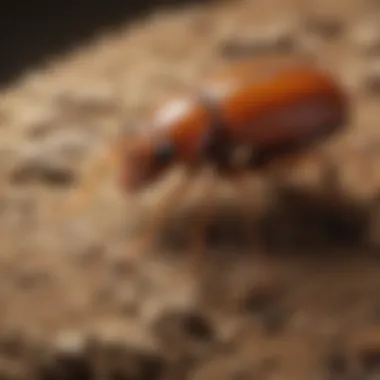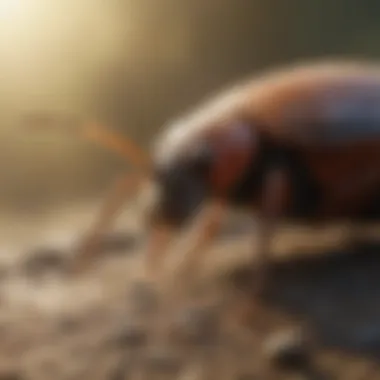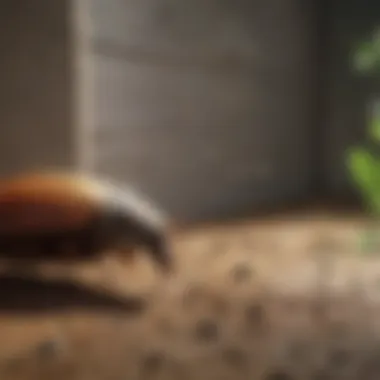La Jolla Termite and Pest Control Guide


Intro
Managing pests effectively is a crucial concern for any homeowner in La Jolla. The coastal climate coupled with diverse vegetation provides an ideal habitat for various pests, notably termites. Understanding these pests, how they proliferate, and the methods for control is essential for maintaining a healthy living environment.
This guide will cover the fundamentals of pest identification, prevention methods, and do-it-yourself control solutions. By the end, readers should have a nuanced understanding of the pest challenges in La Jolla and the strategies available for tackling them.
Pest Identification
Identification is the first step toward effective pest control. If you can recognize the type of pest invading your home, you can choose the most appropriate response. In La Jolla, homeowners frequently encounter several common household pests.
Common Household Pests
The following pests are among the most prevalent in La Jolla:
- Termites: Known for causing extensive structural damage, they are a significant concern for homeowners owners.
- Ants: Carpenter ants can damage wood, while others often invade kitchens seeking food.
- Rodents: Mice and rats can bring diseases and contaminate food supplies.
- Cockroaches: A common nuisance that can trigger allergies and health issues.
- Spiders: While most are harmless, some species may be venomous.
Signs of Infestation
Detecting the signs of an infestation early on is critical to preventing more serious problems. Look for:
- Droppings: Small feces near food sources or nesting areas.
- Nesting Materials: The presence of shredded paper, fabric, or leaves can indicate rodent activity.
- Gnaw Marks: Visible damage on wood or walls may signal rodent or termite intrusion.
- Hollow Sounding Wood: Termites create hollow spaces in wood, leading to a dull thud if tapped.
- Visible Insects: Live insects or their shed skins may be visible, indicating an active infestation.
"Addressing pest issues quickly can save homeowners time and resources in the long run."
Prevention Methods
Preventing pest entry is just as important as managing existing infestations. A proactive approach can significantly reduce the chance of encounters with pests.
Environmental Modifications
Making clever changes in your environment can help thwart pests. Consider:
- Landscaping Choices: Keep plants and shrubs trimmed, and maintain a distance from the property.
- Mulch Management: Use mulch judiciously; it can attract termites if too close to the home's foundation.
- Standing Water: Ensure there are no areas of standing water, which can attract mosquitoes and other pests.
Home Maintenance Tips
Regular home maintenance can deter pest invasions:
- Sealing Cracks: Regularly check for and seal any cracks in walls or foundations.
- Proper Drainage: Ensure gutters and downspouts direct water away from your home.
- Food Storage: Store food in airtight containers to deny access to pests.
DIY Pest Control Solutions
For those who prefer to handle pest issues on their own, several effective DIY methods exist. These approaches can be both economical and satisfying.
Natural Remedies
Natural pest control methods can be less toxic than commercial options. Some examples include:
- Diatomaceous Earth: A non-toxic powder that dehydrates insects when they come into contact with it.
- Essential Oils: Many oils, like peppermint and tea tree oil, can repel various pests
DIY Traps and Barriers
Creating traps or barriers can be effective in controlling pest populations:
- Trap for Rodents: Use simple snap traps to catch rodents, placing them in areas of known activity.
- Sticky Traps: These can be placed in corners to catch crawling insects, like roaches and ants.


Creating a pest-free home in La Jolla requires identifying potential threats, implementing preventive measures, and using effective DIY solutions. Understanding these elements gives you a better chance of maintaining a safe and healthy living space.
Preface to Pest Control in La Jolla
Pest control is not just a maintenance task; it is a crucial aspect of home ownership in La Jolla. This area, with its unique climate and environment, presents specific challenges and risks associated with various pests. Understanding the importance of effective pest control helps homeowners mitigate these risks.
Pest infestations can lead to significant structural damage and health hazards. For instance, termites are not only destructive but can also go unnoticed until the damage is substantial. Similarly, rodents can carry diseases that pose threats to families. Therefore, early detection and intervention are key to protecting your home.
In La Jolla, the variety of pests is influenced by the local ecosystem. This makes tailored pest control approaches necessary. Homeowners need to recognize the specific pests that are prevalent in the area to devise appropriate strategies for prevention and treatment. Knowledge of local species enhances the effectiveness of controlling these pests.
Adopting pest control measures also contributes to the long-term health of your property. Consideration must be given to environmental impacts as well. Eco-friendly methods of pest control are increasingly sought after, providing solutions that are effective yet safe for households and the local wildlife.
To sum up, understanding pest control within the context of La Jolla is vital. It empowers homeowners to not only protect their property but also their family’s well-being. This article aims to provide insights into effective strategies, species identification, and preventive measures tailored for the unique landscape of La Jolla.
Understanding Common Pests in La Jolla
The recognition and understanding of common pests in La Jolla are crucial for effective pest control. In this coastal region, several pests not only threaten the structural integrity of homes but also impact the overall quality of life for residents. Recognizing their behavior, life cycles, and potential risks forms the foundation for implementing effective management strategies.
Termites: An Overview
Termites pose a significant threat in La Jolla. These insects are known for their ability to consume wood and cellulose materials, which can lead to considerable damage in homes. La Jolla's warm climate creates a conducive environment for termite activity throughout the year. With several species present, including the eastern subterranean termite and the drywood termite, understanding their differences is critical.
Subterranean termites typically establish colonies in the soil and can enter homes through cracks in the foundation. They tunnel through wood and can remain undetected for long periods. Drywood termites, on the other hand, live within the wood they consume, making detection even more challenging. Homeowners must prioritize inspections and preventive measures to safeguard their properties against these damaging pests.
Ant Species and Their Behavior
Ants are another prevalent pest in La Jolla. The region is home to various species like the Argentine ant and the carpenter ant. Understanding the behavior of these species can aid in effective control measures. For instance, Argentine ants thrive in colonies and are notorious for invading homes in search of food. They are attracted to sugary and greasy substances, often creating trails to food sources.
Carpenter ants, on the contrary, can cause structural damage as they nest in wood. They do not eat the wood but hollow it out, weakening the structural integrity. Observing ant trails and nests can provide essential insight into the severity of an infestation, allowing for timely interventions.
Rodents: Identification and Risks
Rodents, including house mice and roof rats, are common in La Jolla and can pose health risks to homeowners. They can enter structures through small openings and may reproduce rapidly if not addressed. House mice are often identified by their small size, pointed snouts, and long tails. They tend to nest in hidden, sheltered areas, making it hard to detect their presence.
Roof rats are larger and more agile, often found in higher areas like roofs or trees. They can be problematic as they can carry diseases and contaminate food supplies. Homeowners need to be vigilant about signs of rodent activity, such as droppings or gnaw marks, to mitigate risks promptly. Implementing control methods is essential to protect both health and property.
Signs of Infestation
Understanding the signs of infestation is crucial in managing pest problems effectively. Early detection can prevent minor issues from escalating into significant infestations that may cause severe damage and health risks. Recognizing these signs can save homeowners considerable costs associated with extensive treatments and repairs. In La Jolla, where specific pest types thrive, it is essential to be familiar with the indicators that may signal the presence of termites, ants, or rodents. This section focuses on visual inspection, behavioral cues, and direct evidence of these pests, equipping readers with practical knowledge to identify and act upon these signs.
Visual Indicators of Termites
Termites are notorious for their destructive capabilities. Homeowners should look for particular visual signs that indicate a termite presence.
- Mud Tubes: Termites often build mud tubes as protective highways between their nests and food sources. Inspect your home's foundation and exterior for these small tunnels, which are typically pencil-sized and made from soil and saliva.
- Damaged Wood: Termites tunnel through wood, creating tunnels inside. If you tap wooden structures and find hollow sounds, this may indicate termite damage.
- Swarmers: In spring, winged termites, called swarmers, may emerge from existing colonies to establish new ones. Spotting these insects inside or around your home could signify an active infestation.
More frequent inspections will help homeowners catch these indicators early, minimizing potential damage from termites.
Common Signs of Ant Infestation
Ants can be a nuisance, and identifying their signs is necessary for effective control. Here are common indicators:
- Ant Trails: Ants follow pheromone paths to and from food. If you notice a consistent line of ants moving to a specific source, you may have an infestation.
- Nesting Areas: Look for ant nests, which may appear as small mounds or openings in the ground. Inside homes, they can nest in walls, insulation, or even behind appliances.
- Food Sources: If you find food crumbs or residue near entry points, this may attract ants. Keeping an eye on food storage and cleanliness can help prevent infestations.
By understanding these signs, homeowners can take proactive steps to manage ant populations before they become overwhelming.
Identifying Rodent Activity


Rodents like mice and rats can pose serious health threats. Their signs are often unmistakable. Look for:
- Droppings: Rodent feces can typically be found along walls, near food packages, or inside cupboards. Mouse droppings are small and dark, while rat droppings are larger and cylindrical.
- Gnaw Marks: Rodents have strong teeth that they use to chew through various materials. If you find gnaw marks on furniture, wires, or food packages, this indicates rodent activity.
- Nests: Rodent nests are usually made from paper, fabric, or insulation, and can often be found in hidden areas, such as lofts, basements, or garage spaces.
Prompt recognition of these signs can help in devising an effective pest control plan.
"Identifying the signs of infestation is the first step in effective pest management. Early detection can save homeowners time, money, and stress."
Prevention Strategies for Homeowners
In La Jolla, pest control is not just about reacting to an infestation; it’s about prevention. Homeowners play a critical role in minimizing the risk of pest problems. Implementing effective prevention strategies can save time, money, and stress in the long run. This section covers key areas that are essential for homeowners to address, ensuring their property remains pest-free.
Eliminating Entry Points
One of the first steps in pest prevention is to eliminate entry points. Pests can enter homes through surprisingly small openings. Cracks in the foundation, gaps around windows and doors, and holes in screens are all common pathways. Regular inspections are vital, especially after seasonal weather changes that may create new vulnerabilities.
- Seal gaps with caulk or foam. Pay close attention to areas where pipes enter the home.
- Use door sweeps to create a barrier at the bottom of exterior doors.
- Repair damaged screens promptly to keep insects out.
These measures are easy to implement and can significantly reduce the likelihood of pests finding their way indoors.
Environmental Modifications
Altering the surrounding environment can greatly contribute to pest management. Pests thrive when conditions are favorable. Hence, homeowners should consider making modifications to the landscape and surrounding areas.
- Trim branches and bushes, keeping them away from the house to reduce access.
- Maintain a clean yard, disposing of debris or standing water that can serve as breeding grounds.
- Use gravel in flower beds instead of mulch. This can deter termites and other pests seeking shelter.
These strategies not only keep pests at bay but also enhance the aesthetic appeal of the property, making it a more pleasant place to live.
Ongoing Maintenance Practices
Consistent maintenance is key to any successful pest prevention strategy. Homeowners should establish a routine that includes regular checks and updates to their pest control practices.
- Routine inspections should be scheduled every few months to identify any potential problems early.
- Clean gutters to prevent water accumulation that attracts pests.
- Regularly update treatments for existing pest issues to ensure they remain effective.
Ongoing maintenance fosters an environment that is less hospitable to pests, ultimately leading to a healthier home. By dedicating time to these practices, homeowners demonstrate proactive care that protects their investment.
Regular inspection and maintenance are not just recommendations; they are essential strategies that empower homeowners to take charge of their living spaces.
Professional Pest Control Services
Professional pest control services play a crucial role in maintaining a pest-free environment, particularly in areas like La Jolla, where specific pest challenges prevail. The presence of pests can severely affect the integrity of a home and the well-being of its inhabitants. Thus, understanding the benefits and considerations of hiring a professional service is important for homeowners.
One significant advantage of relying on expert pest control is their specialized knowledge. Professionals are trained to identify different pests and understand their behaviors, life cycles, and breeding habits. This expertise allows them to formulate targeted strategies that are more effective than general do-it-yourself approaches. Moreover, professionals have access to advanced tools and treatments that may not be available to the public, ensuring a more thorough and efficient pest management process.
Additionally, utilizing professional services can lead to long-term cost savings. While the initial investment may seem high, their services often prevent extensive damage that could arise from unaddressed infestations. Without effective pest control, homeowners may face costly repairs and replacements down the line.
Considerations when choosing a professional pest control provider include their reputation, service offerings, and customer reviews. It is essential to select a company that is licensed and insured, as this ensures compliance with industry standards and safety measures.
It is wise to research and ask for recommendations to find reliable pest control services that fit your needs.
Choosing a Pest Control Provider
Choosing the right pest control provider is fundamental. Start by researching local companies specializing in pests specific to La Jolla. Check their qualifications and ensure they possess the necessary licenses. Asking for references or reading online reviews can also provide insights into their effectiveness and customer service. It is also important to consider whether they offer eco-friendly options, as this reflects their commitment to safe pest management practices.
What to Expect from Inspections
During inspections, pest control professionals will conduct a thorough assessment of your property. This includes examining both the interior and exterior, checking for signs of pest activity, and identifying potential entry points. You can expect them to take notes and, if necessary, provide you with a detailed report afterward. This inspection is critical in understanding the extent of the infestation and planning the best course of action for treatment.


Assessing Treatment Options
Once the inspection is complete, professionals will discuss various treatment options tailored to your home and situation. They may suggest a combination of chemical treatments, baits, or natural solutions depending on the type and severity of the pest problem. This personalized approach not only addresses immediate concerns but also provides strategies for preventing future infestations. Homeowners should ask questions about each option, including environmental impacts and effectiveness to make informed decisions.
Eco-Friendly Approaches to Pest Control
In recent years, the topic of eco-friendly pest control has gained considerable attention. This approach is important for several reasons, particularly in areas like La Jolla, where the natural environment is diverse. Environmental health, reducing chemical exposure, and sustainable practices are key benefits of using eco-friendly methods. Emphasizing these strategies not only protects the local ecosystem but also enhances the well-being of homeowners and their families.
Understanding Integrated Pest Management
Integrated Pest Management (IPM) stands as a structured approach to pest control that combines different strategies for effective results. IPM seeks to minimize the use of chemicals, opting instead for a mix of physical, biological, and environmental controls.
Some critical elements of IPM include:
- Monitoring: Regular assessments of pest populations help in understanding the level of infestation and determining an appropriate response.
- Prevention: This involves removing or minimizing pest habitats, such as stagnant water and debris, which enables a proactive rather than reactive approach.
- Control Methods: When pest intervention is necessary, the focus is on using methods that are less harmful to the environment, such as introducing natural predators or utilizing traps.
IPM is considered more sustainable because it encourages a balanced ecosystem, reducing the likelihood of pest resurgence. Homeowners can also see positive effects on their gardens and landscapes, as beneficial insects are preserved while harmful pests are managed.
Natural Remedies for Pest Control
Natural remedies for pest control offer a viable alternative to traditional chemical treatments. These methods can be both simple and effective in preventing pest problems without the downsides associated with synthetic pesticides. Here are some widely recognized natural solutions:
- Essential Oils: Many essential oils, such as peppermint and tea tree oil, have repellent properties. They can be mixed with water and sprayed around entry points to deter pests.
- Diatomaceous Earth: This natural powder is effective against crawling insects. It damages their exoskeletons and leads to dehydration. Homeowners can sprinkle it in areas where pests are active.
- Vinegar Solutions: A mixture of vinegar and water works well as a cleaner and can repel ants and other common pests.
Utilizing natural remedies promotes a safer living environment, especially for households with children and pets. However, it is essential to be consistent with these methods, as natural approaches may take longer to provide visible results compared to chemical options.
"Eco-friendly approaches not only tackle pest issues effectively but also contribute to a healthier home and environment, making a significant difference in pest management strategies for La Jolla."
To sum up, embracing eco-friendly pest control methods such as Integrated Pest Management and natural remedies can empower homeowners in La Jolla. These approaches prioritize ecological balance while effectively managing pests, thus ensuring a safer and healthier home environment.
DIY Pest Control Techniques
DIY pest control techniques empower homeowners to take charge of their living spaces. These strategies are not just cost-effective; they also foster a sense of personal responsibility towards home maintenance. Understanding and implementing DIY methods can be beneficial, especially for residents in La Jolla, who face unique pest challenges. By employing DIY solutions, homeowners can often prevent infestations before they escalate, ultimately protecting their homes and investments.
Creating Effective Traps
Trapping is one of the fundamental methods for managing pest populations. It serves dual purposes: it helps in identifying the type of pests present and actively reduces their numbers. For effective traps, homeowners need to consider a few key factors:
- Type of Pest: Different pests require different types of traps. For instance, sticky traps are good for monitoring insect activity, while snap traps are better suited for rodents.
- Location: Effective trap placement is crucial. Identify areas where pests are most active, such as near entry points, food sources, or nesting sites.
- Bait: Use appropriate bait that attracts the specific pest type. For example, peanut butter works well for mice, while sugary substances may attract ants.
Once traps are in place, check them regularly. Remove any caught pests promptly and reset the traps. This not only maintains trapping efficiency but also ensures hygiene within the home.
Homemade Repellents
Homemade repellents can be a practical and eco-friendly option for pest control. Many store-bought repellents contain chemicals that might be harmful to both humans and pets. Instead, opting for natural substances can be an effective alternative. Here are some ingredients you can use:
- Vinegar: Mix vinegar with water and spray around entry points. Its strong smell deters many pests.
- Essential Oils: Oils like peppermint or tea tree can repel insects. Dilute with water and spray around infested areas.
- Dish Soap: A mixture of water and dish soap can effectively kill soft-bodied insects like aphids or mites when sprayed directly.
Applying these homemade solutions regularly can help keep pests at bay. They can be particularly useful during peak pest seasons when infestations are more likely to occur.
End
In the realm of pest control, particularly in La Jolla, understanding and addressing termite and pest issues is crucial for homeowners. The significance of this conclusion is multifaceted. It not only serves to summarize the key learnings from the article but also emphasizes the importance of being proactive in pest management.
First, acknowledging that pest infestations can lead to structural damage and various health risks is essential. Termites, for example, can compromise the integrity of wooden structures, leading to costly repairs. Rodents can harbor disease, posing a danger to family members. Therefore, awareness and early detection are vital to mitigating these risks.
Second, the strategies discussed throughout the article reinforce the idea that homeowners have control over their environments. By implementing prevention techniques and utilizing professional services when necessary, individuals can create a pest-free sanctuary. This empowerment reinforces the belief that with the right knowledge and tools, effective pest control is achievable.
Moreover, the advancements in eco-friendly approaches highlight a significant shift toward sustainable practices. Homeowners are now more inclined to seek methods that minimize harm to the environment. Understanding integrated pest management and natural remedies offers alternatives that align with this shift in mindset.
Lastly, the importance of ongoing maintenance cannot be overlooked. Pest control is not a one-time event, but rather an ongoing commitment. Regular inspections and maintenance not only keep pests at bay but also bolster home value and safety.
"Proactive pest control protects your home and enhances your quality of life."















